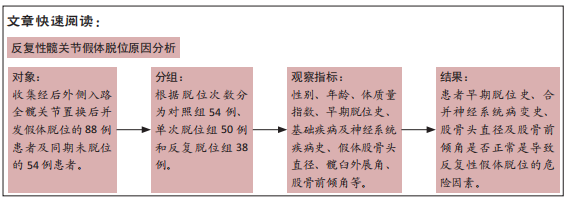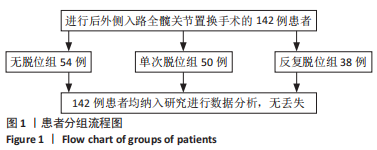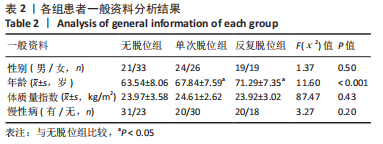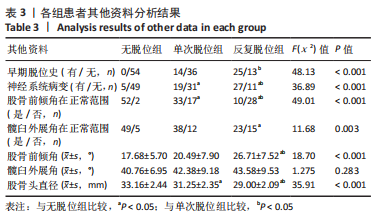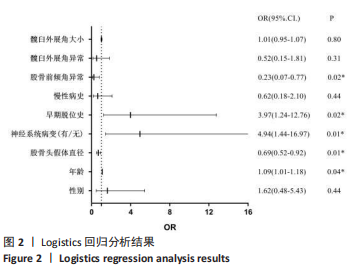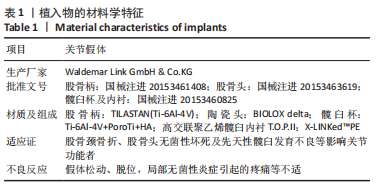[1] GRAVES SE, DE STEIGER R, DAVIDSON D, et al. The use of femoral stems with exchangeable necks in primary total hip arthroplasty increases the rate of revision. Bone Joint J. 2017;99-B(6):766-773.
[2] 劳世高,罗任,蒙芝健,等.人工髋关节置换后脱位与前外侧入路修复髋关节囊的关系[J].中国组织工程研究,2015,19(44):7087-7091.
[3] ABDEL MP, CROSS MB, YASEN AT, et al. The functional and financial impact of isolated and recurrent dislocation after total hip arthroplasty. Bone Joint J. 2015;97-B(8):1046-1049.
[4] EKMAN E, NURMI H, REITO A, et al. Complications following 250 cemented modular hip hemiarthroplasties. Scand J Sur. 2019;108(4):321-328.
[5] 苏兴平,孔令俊,王承祥,等.后方关节囊修补预防老年全髋关节置换术后早期脱位[J].中国中医骨伤科杂志,2015,23(6):42-43.
[6] GROMOV K, TROELSEN A, OTTE KS, et al. Removal of restrictions following primary THA with posterolateral approach does not increase the risk of early dislocation-reply. Acta Orthop. 2015;86(4):518-519.
[7] KORNUIJT A, DAS D, SIJBESMA T, et al. The rate of dislocation is not increased when minimal precautions are used after total hip arthroplasty using the posterolateral approach: a prospective, comparative safety study. Bone Joint J. 2016;98-B(5):589-594.
[8] NEVELOS J, JOHNSON A, HEFFERNAN C, et al. What Factors Affect Posterior Dislocation Distance in THA? Clin Orthop Relat Res. 2013;471(2):519-526.
[9] 史思峰,卢文海,周冰,等.保护股方肌及修复后方软组织对后外侧入路全髋关节置换早期脱位的影响[J].中国组织工程研究,2016,20(48):7163-7168.
[10] 王若禺,韩立志,龚松,等.初次全髋关节置换后早期脱位的危险因素分析[J].华中科技大学学报(医学版),2020,49(1):122-125.
[11] 朱东明,张振,张杰,等.全髋关节置换后假体脱位危险因素的最新进展[J].中国组织工程研究,2020,24(36):5864-5870.
[12] 刘博,苏祎,李彦仓,等.陈旧性髋关节脱位人工髋关节置换术后并发假性动脉瘤破裂1例[J].广东医学,2013,34(20):3198.
[13] 戴繁林,张鹏,黄晓华,等.人工全髋关节置换术中后方软组织不同处理方式对术后假体脱位的影响[J].中国骨与关节损伤杂志,2015,30(10):1013-1016.
[14] 朱先洋,尹宗生,陈迪嘉.髋关节置换术后翻修原因及疗效分析[J].安徽医药,2017,21(3):525-528.
[15] 艾进伟,韩叶萍,李光辉,等.仿生双动关节重建髋关节的稳定性[J].中国组织工程研究,2017,21(27):4271-4276.
[16] 何伟,周驰,王海彬,等.初次全髋关节置换术后反复脱位的原因分析及处理策略[C]. 中华医学会.中华医学会第十七届骨科学术会议暨第十届COA国际学术大会论文集,2015,1-1.
[17] D’A PUZZO MR, N EVELOS J, YEAGER A, et al. Relative head size increase using an anatomic dual mobility hip prosthesis compared to traditional hip arthroplasty: impact on hip stability. J Arthroplasty. 2014;29(9):1854-1856.
[18] JAMESON SS, LEES D, JAMES P, et al. Lower rates of dislocation with increased femoral head size after primary total hip replacement: a five-year analysis of NHS patients in England. J Bone Joint Surg Br. 2011;93(7):876-880.
[19] HAUGHOM BD, PLUMMER DR, MORIC M, et al. Is There a Benefit to Head Size Greater Than 36 mm in Total Hip Arthroplasty? J Arthroplasty. 2016;31(1): 152-155.
[20] LUO Y, SUN XF, CHEN J, et al. Could larger diameter of 4th generation ceramic bearing increase the rate of squeaking after THA? A retrospective study. Medicine (Baltimore). 2018;97(52):e13977.
[21] LEWINNEK GE, LEWIS JL, TARR R, et al. Dislocations after total hip-replacement arthroplasties. J Bone Joint Surg Am. 1978;60(2):217-220.
[22] 郑志博,冯宾,董玉雷,等.全髋关节置换术后脱位因素分析及防治策略[J].中华骨与关节外科杂志,2016,9(3):198-203.
[23] AMUWA C, DORR LD. The combined anteversion technique for acetabular component anteversion. J Arthroplasty. 2008;23(7):1068-1070.
[24] BOSKER BH, VERHEYEN CC, HORSTMANN WG, et al. Poor accuracy of freehand cup positioning during total hip arthroplasty. Arch Orthop Trauma Surg. 2007;127(5): 375-379.
[25] FUJITA K, KABATA T, MAEDA T, et al. The use of the transverse acetabular ligament in total hip replacement: An analysis of the orientation of the trial acetabular component using a navigation system. Bone Joint J. 2014;96-b(3):306-311.
[26] MA JX, KUANG MJ, FAN ZR, et al. Comparison of clinical outcomes with InterTan vs Gamma nail or PFNA in the treatment of intertrochanteric fractures: A meta-analysis. Sci Rep. 2017;7(1):5962.
[27] SUH KT, KIM DW, LEE HS, et al. Is the dislocation rate higher after bipolar hemiarthroplasty in patients with neuromuscular diseases? Clin Orthop Relat Res. 2012;470(4): 1158-1164.
[28] LUTONSKÝ M, VALIS M, SROT J. Total hip arthroplasty after femoral neck fracture in patients with acquired neurological deficit. Acta Chir Orthop Cech. 2009;76(3):239-242.
[29] 万安营,唐淼,汤瑞新,等.老年患者后外侧入路全髋关节置换术后假体脱位的原因及对策[J].包头医学院学报,2015(6):61-62.
[30] KOBAYASHI S, KUBO T, IWAMOTO Y, et al. Nationwide multicenter follow-up cohort study of hip arthroplasties performed for osteonecrosis of the femoral head. Int Orthop. 2018;42(7):1661-1668.
[31] BERRY DJ, VON KNOCH M, SCHLECK CD, et al. The cumulative long-term risk of dislocation after primary Charnley total hip arthroplasty. J Bone Joint Surg Am. 2004;86(1):9-14.
[32] FESSY MH, PUTMAN S, VISTE A, et al. What are the risk factors for dislocation in primary total hip arthroplasty? A multicenter case-control study of 128 unstable and 438 stable hip. Orthop Traumatol Surg Res. 2017;103(5):663-668.
[33] WAGNER ER, KAMATH AF, FRUTH KM, et al. Effect of Body Mass Index on Complications and Reoperations After Total Hip Arthroplasty. J Bone Joint Surg Am. 2016;98(3):169-179.
[34] ESPOSITO CI, GLADNICK BP, LEE YY, et al. Cup position alone does not predict risk of dislocation after hip arthroplasty. J Arthroplasty. 2015;30(1):109-113.
|
